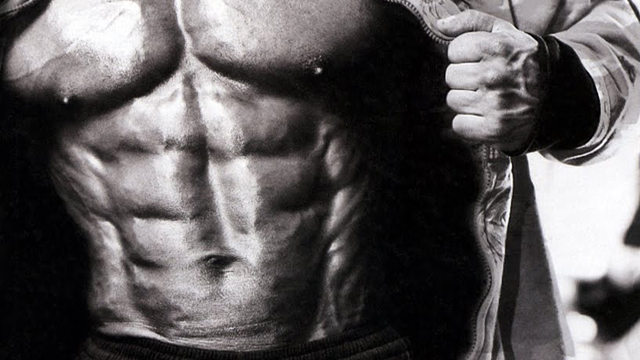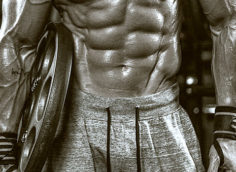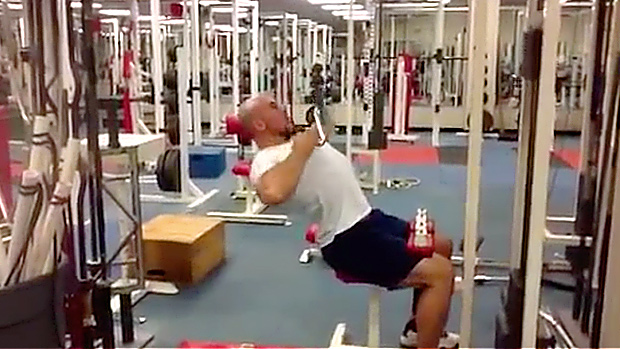Cardiovascular work (cardio) is a multifaceted tool. It improves health and aerobic conditioning, helps with recovery and restoration from weight training, and burns fat.
This article will explore that last benefit, the one most of us are concerned about, fat loss. I'll discuss the different types of cardio as well as how and when to implement them to burn the most fat while retaining the most muscle.
So tie up your laces, crank up the jams, and let's get moving.
Cardio burns calories (hopefully from fat) and is ideally paired with an intelligent diet to create a "negative calorie balance" that will shed fat and retain muscle.
The old "calories in versus calories out" mantra is usually discussed in relation to the diet end of things, but despite what some laptop gurus may say, you can't just starve yourself to contest-winning condition.
Certainly, you can shed a lot of fat with diet alone, but if you want to obtain a truly optimal physique and you weren't born with a hummingbird-like metabolism, you're going to have to sweat some out, too. Sitting on the sofa playing PS3 all day while eating orange roughy and asparagus won't lead to standing in the winner's circle.
The actual mode of activity can vary greatly (treadmill, swimming, rollerblading, the Stepmill machine) but it's the intensity that differentiates between the types of cardio. Generally, there are three levels of intensity (high, moderate, and low), typically specified by the heart rate (in beats per minute).
A simple formula is to subtract your age in years from 220, with that number representing your maximum heart rate. So if you're 25 years-old, your maximum heart rate would be 195 (220-25 = 195).
Most define "moderate intensity" as approximately 65 to 70% of max, so our 25 year-old example would take 195 and multiply it by .65 to get 65%, resulting in roughly 127 beats per minute. Seventy percent would be roughly 137 (195 multiplied by .7), so to work at moderate intensity through whatever modality he chooses (treadmill, biking, elliptical, etc.), Mr. 25 year-old would keep his heart rate between 127 and 137 beats per minute.
For most this is equivalent to a good jog where you work up a sweat and are working relatively hard but could still kind of hold a meaningless conversation with the person next to you, if you're that type of gym pariah.
Low intensity is usually defined as anything less then 65% – some will just make it easy and say "under 130 beats per minute." Again, with a little math, our 25 year-old example multiplied 195 by .65 to reach 127 for low intensity. So just keep your heart rate below that number.
High intensity can vary a bit. Eighty to 85% is a common range, and for high intensity interval training, heart rates aren't typically used, or at least I don't use them.
You have periods of all-out sprinting (close to max, although you'll probably never reach it) coupled with periods of more moderate intensity (where your heart will probably still feel like it's about to blow out of your chest). One method I like to use is after a general warm-up, do sprint intervals where you sprint at an all-out max for 15 seconds, then do 45 seconds at a moderate pace (about a jog). Repeat this without breaks in between, ten to twenty times, and then do a cool-down.
Note: As your conditioning improves, it'll take more or harder work to get your heart rate up to your target level. If you haven't exercised much lately, it might just take brisk walking on a treadmill at a relatively low speed and incline to do so, but after dieting and conditioning for a month or two, it often requires a much higher incline and speed to reach the same number. This is a good thing! It means you're getting more fit. You have to work harder to get your heart rate up.
Put simply, cardio intensity should match your carbohydrate intake. If you're consuming a lot of carbohydrates in your diet, even if it's set up for fat loss, then high intensity is the way to go. Too much high intensity cardio can still sap energy and interfere with training and recovery, even with a higher carb intake, so limit HIIT work to three or four sessions per week.
If you need more cardio than that, make the balance low to moderate intensity. I typically start off clients with two or three HIIT sessions per week, and one or two moderate sessions.
On the other hand, if your carbohydrate intake is very low – perhaps you have insulin sensitivity issues and need to follow more of a ketogenic plan to lose fat – then ditch the high intensity stuff. You'll risk too much muscle catabolism with it, so stick with low to moderate intensity cardio work.
High intensity cardio requires glycogen to perform, and without glycogen (like when on a low carb diet), the body will provide its own, from muscle stores. In other words, you'll eat your own muscle to supply energy for the high intensity cardio. Not what we want at all.
Every so often I'll have a client do high intensity work on a low carb diet, but this is very rare, and only after other options have failed to rid them of their "stubborn fat." Don't immediately assume you're one of these genetic outliers. Stick to the basic recommendations first.
This is a somewhat controversial topic. There are many staunch advocates of "morning fasted cardio," and just as many fervent believers that "it really doesn't matter."
In my experience working with hundreds of clients over the years, I've found that morning fasted cardio does provide better results than cardio performed at other times. That's not to say that if your mornings are busy and you can't get cardio done then you can't get ripped – surely you can – but if you do have the option of completing cardio in the morning versus later in the day, I'd definitely opt for the former.
Some might stress about potential muscle loss with fasted cardio, but if total diet is in line the chances of catabolism are very low. If the human body was so fragile that it lost muscle doing some physical activity before eating, we'd never have survived as a species.

Here are my top reasons to do morning cardio:
- After an overnight fast, your body is slightly glycogen depleted and insulin levels are low, so fat will be the primary fuel source for cardio (at least for low to moderate intensity cardio).
- Morning cardio is a great way to start your day. It releases endorphins that make you feel better both physically and mentally.
- Getting it done first thing makes it less likely to be something you'll skip later.
- Morning cardio (especially high intensity) raises your metabolism for hours afterwards, so you're not just burning calories while you're on the machine, you're burning calories even while at rest.
As stated, you can still get ripped doing cardio at other times of the day if your schedule (or temperament) doesn't permit morning fasted cardio. The most important factor is just getting it done, whatever time of day it might be.
Other good times to do cardio include post workout, before your post workout meal. You're glycogen depleted, so fat burning will be optimized. Another good time is in the evening, after tapering off carb intake. This can be between meals, or even after your last meal of the day, although some find going to sleep after late-evening cardio troublesome. If this is you, stick with other times.
While I'm not a big fan of eating before cardio, I do like judicious supplement use. A thermogenic fat burner like Hot-Rox® Extreme taken a half hour before cardio and training sessions will not only help free up fatty acids to be used as fuel, it will motivate you for the session while suppressing appetite.
The least amount necessary! Always start off with a moderate amount (perhaps three sessions per week, 25-30 minutes each). Monitor your fat loss (and muscle maintenance) progress week to week. When things start to plateau, consider changing your diet and/or increasing the cardio a bit.
By "a bit" I mean adding one or two sessions per week (perhaps 4-5 sessions x 30 minutes), not going to two hours a day, seven days a week. The problem with jumping "whole hog" into cardio is that you don't leave any tricks up your sleeve for when you do plateau.
Once you hit seven 30 minute sessions per week, look at increasing the durations in 5-10 minute increments at a time. So seven sessions of 35 to 40 minutes; depending on your goals, timeline, and metabolism.
What about pushing the Prowler, dragging a sled, hill sprints, stuff like that?
Those are all great, and the change in modality will help prevent cardio from becoming too boring. They also have great recuperative and GPP (general physical preparedness) benefits. Just keep in mind the heart rate values discussed earlier, and use the right ones for your particular diet setup.

Taking "baby steps" is a good way to ensure that you get the biggest bang out of your cardio buck. How much you can eventually work up to though depends on your goals, timeline, and metabolism, but I generally don't like clients doing much more than an hour per day, unless they're in the final few weeks of contest prep and more is needed to pull off the last bits of stubborn fat.
Every so often I have clients go up to two or even three hours per day (all low intensity at that point) but those cases are rare. It would be better to just diet longer with less cardio, than stress the body and risk possible catabolism and mental burnout from that much cardio. Remember that diet is key and needs to be set up properly as well.
NOTE: Don't just increase cardio as you progress in your diet – also diminish calories (typically from carbs and fat). When prepping clients I pull fairly equally from both ends of the calories in (diet) and calories out (cardio) spectrum.
Ideally, I like to have clients very close to stage ready at about two weeks out, so we can taper back cardio a bit and let their body rest and recuperate into the show. You want to look fresh and full onstage, not beat down like you just finished a marathon.
"Off-season" cardio should be relatively minimal. Around three to four sessions per week, 20-30 minutes each is plenty. Keep most at moderate intensity but one HIIT session per week would be a good idea. Keep offseason cardio to non-training days, or at least separated from weights by 6-8 hours.
Coupled with a solid diet this is usually plenty to keep conditioning in check, appetite up, and give some active recovery from training.
A sample weekly off-season setup might look something like this:
- Monday: Lower body (squat based). No cardio.
- Tuesday: Rest day. Low to moderate intensity cardio (restoration, fat burning).
- Wednesday: Upper body (bench based). No cardio.
- Thursday: Rest day. High intensity interval cardio (conditioning, fat burning).
- Friday: Lower body (deadlift based) No cardio.
- Saturday: Rest day. Low to moderate intensity cardio (restoration, fat burning).
- Sunday: Accessory work. Low to moderate intensity cardio (restoration, fat burning).
Wrap-Up
Like diet, cardio work doesn't fit well into "cookie cutter" templates. It needs to be customized to your specific situation, as well as monitored and adjusted as you progress through your diet. Stick with the principles outlined above and you'll be well on your way to physique perfection.





